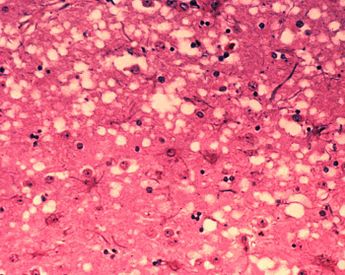Self-repairing mechanism helps to preserve brain function in neurodegenerative diseases
June 20, 2014

Prion-infected tissue (credit: Dr. Al Jenny – Public Health Image Library)
Neurogenesis, the self-repairing mechanism of the adult brain by creating new neurons, can help to preserve brain function in neurodegenerative diseases such as Alzheimer’s, Prion, and Parkinson’s, new research led by scientists at the University of Southampton has found.
The progressive degeneration and death of the brain, occurring in many neurodegenerative diseases, is often seen as an unstoppable and irrevocable process.
But now, a research team, led by Diego Gomez-Nicola, DPhil, from the Centre for Biological Sciences at the University of Southampton, has detected increased neurogenesis in the dentate gyrus (part of the brain system controlling learning and memory, the hippocampus) that partially counteracts neuronal loss.
An optimal time window for self-repairing
Using a model of prion disease from mice, the research identified the time-course of the generation of these newborn neurons and how they integrate into the brain circuitry. While this self-repairing mechanism is effective in maintaining some neuronal functions at early and mid-stages of the disease, it fails at more advanced phases. This highlights a window of time in which potential therapeutic intervention could preserve the beneficial effects of enhanced neurogenesis.
“This study highlights the latent potential of the brain to orchestrate a self-repairing response,” said Gomez-Nicola. “The continuation of this line of research is opening new avenues to identify what specific signals are used to promote this increased neurogenic response, with views focused in targeting neurogenesis as a therapeutic approach to promote the regeneration of lost neurons.”
The study, which is published in the journal Brain (open access), also involves the Universities of Hamburg and Valencia. It is funded by the European Union Seventh Framework Programme and the Medical Research Council (MRC).
Abstract of Brain paper
The study of neurogenesis during chronic neurodegeneration is crucial in order to understand the intrinsic repair mechanisms of the brain, and key to designing therapeutic strategies. In this study, using an experimental model of progressive chronic neurodegeneration, murine prion disease, we define the temporal dynamics of the generation, maturation and integration of new neurons in the hippocampal dentate gyrus, using dual pulse-chase, multicolour γ-retroviral tracing, transmission electron microscopy and patch-clamp. We found increased neurogenesis during the progression of prion disease, which partially counteracts the effects of chronic neurodegeneration, as evidenced by blocking neurogenesis with cytosine arabinoside, and helps to preserve the hippocampal function. Evidence obtained from human post-mortem samples, of both variant Creutzfeldt-Jakob disease and Alzheimer’s disease patients, also suggests increased neurogenic activity. These results open a new avenue into the exploration of the effects and regulation of neurogenesis during chronic neurodegeneration, and offer a new model to reproduce the changes observed in human neurodegenerative diseases.